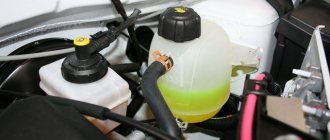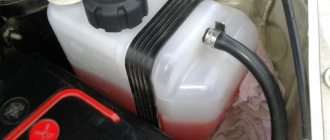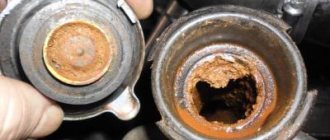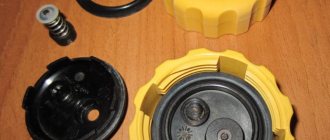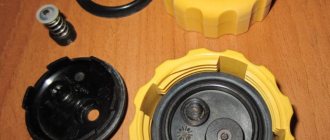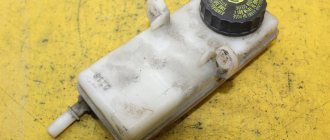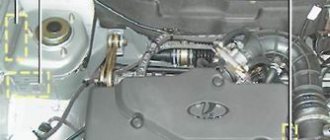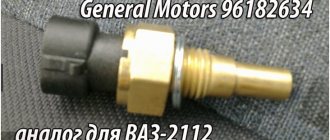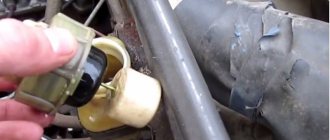To remove the element, simply unfasten the rubber retainer
Insert a new one in its place, secure it with a clamp and connect all the pipes in the reverse order, using new clamps.
The new part is inserted into the niche in place of the old one and secured with a clamp
On VAZ 2110 and 2114 cars, disassembly and installation of a new part are carried out in the same way. The only difference is the location of the tank.
To add antifreeze to a level between the Min and Max marks on the tank wall without creating an air lock in the system, disconnect the tube from the throttle valve heating unit (this is the highest point of the cooling circuit). Pour liquid into the tank until it runs out of the removed tube, then put it on the fitting and secure it with a clamp. Add antifreeze to the required level.
Before pouring antifreeze into the system, you need to remove one of the pipes connected to the throttle valve block
During the replacement process, you should pay attention to the condition of the hoses leading to the container. If their ends have become soggy and increased in diameter, and cracks have formed on the walls, it is better to change such pipes.
Video: replacing the tank on a VAZ 2110
Installation of an expansion tank from Priora
The capacity of the engine cooling system of the VAZ 2170 is distinguished by thicker walls, thanks to which Priora has forever gotten rid of the “childhood disease” of a bursting tank inherent in the VAZ 2110. There is another reason: in the standard tank of the “tens”, a stream of antifreeze from the radiator pipe hits from the inside directly into the lid , which is why the latter leaks. On the “Prior” part, the fittings are at an angle to the neck, so liquid does not get there.
The tank fittings from the VAZ 2170 are directed away from the filler neck
Since the part from the VAZ 2170 is wider than the standard element, its installation is associated with some difficulties: the tank will not simply fit into the narrow space between the glass and the partition. What should be done:
- Remove the windshield wipers by unscrewing the mounting nuts.
Remove the upper body panel.
In order for the wide element from Priora to fit into a narrow opening, you will have to remove the partition trim
Expansion tanks for Priora come in two types - with 2 and 3 fittings (the first are installed on a car with air conditioning). You need a second type of part to connect three hoses.
Installation of pipes and filling of coolant is carried out using the technology described in the previous section. As for modifications of the VAZ 2114-15, where the expansion vessel is located in a wide niche in front of the pillar glass, such a replacement will not cause any difficulties.
Video: tank from Priora on a VAZ 2110
The work of replacing the expansion tank on machines of the “tenth” family should be done independently if you want to save personal time and money. A trip to a car service center will take longer and cost more. At the end of the procedure, do not forget to check the operation of the cooling system by warming up the engine to operating temperature and turning on the electric fan.
First of all
Try replacing the cover with a new one or using a known working one for the duration of the test.
Notice how much the tank swells. If it is not significant and it is clear that it is not due to excess pressure, and you are the owner of a VAZ 2110-12, then you should not worry too much, since this is considered the norm for such cars.
The fact is that new tanks for such cars have a finless design and are made of plastic, which does not hold its shape very well, so over time they begin to swell.
Expansion tanks from Lanos, Priora, Nexia have proven themselves well; they are often installed instead of VAZ ones.
If the tank swells strongly and ruptures, even after replacing it along with the lid, then pay attention to the following points:
- Does the coolant boil?
- What color is the oil in the engine crankcase?
- Are there gases from the combustion chamber in the tank?
- What is the pressure in the cooling system;
- The quality of the tank itself.
How to replace the expansion tank with a new one
If the expansion tank on your VAZ 2112 is out of order, there is only one way out - replacement. Let us briefly describe this simple procedure that you can complete in just 15 minutes of your personal time.
- 1. Partially drain the coolant into a clean container using the drain plug on the radiator in sufficient quantity to easily remove the empty tank.
- 2. Loosen the clamps of the steam exhaust and filling hoses and fold the communications of the cooling system of the VAZ 2110 (2112) to the side.
- 3. By disconnecting the fastening clamp, you can remove the VAZ 2110 expansion tank from the hood.
The reverse installation is similar and should not cause you any difficulties. Do not forget to add coolant to the tank according to the marks indicated on the tank. In order to get rid of air, it will be enough to let the engine run for several minutes at high speeds.
Gases in the expansion tank
The presence of gases in the expansion tank indicates that the cylinder head gasket has burned out, all signs of this problem. This is one of the main reasons why it can become bloated.
Burnout of the gasket could occur due to overheating of the engine, unless, of course, the time for its overhaul has arrived, since it is at 150 - 250 thousand km. mileage the service life of this gasket is calculated.
But there is an important point here - the reservoir will not expand if the valve in the roof is working properly, since excess pressure will still be released, but the engine will overheat. But, if the flow of gases is very strong, then the valve will not have time to release the pressure and the tank will eventually swell and even rupture.
In order to detect the presence of gases in the cooling system, you must:
- Visually inspect the coolant in the barrel with the engine running and make sure there are bubbles or not. If there are bubbles, then the gasket is most likely broken.
- A more accurate method is to use a gas analyzer. The device will accurately indicate the presence of gases.
- Use balloons or similar (well, you get the idea). The ball is placed on the neck of the tank and tied tightly with threads. You need to start the engine when it is cold, before the heated coolant begins to expand greatly. If the product inflates quickly, it means that exhaust gases are entering the cooling system, this is only possible through the cylinder head gasket.
- Check engine compression. If the car's mileage is not very high, then the compression should be normal, since the cylinder-piston group has not yet worn out. But if the cylinder head gasket is broken, the compression meter will show readings below normal.
You can also check in the area of which cylinder the gasket is broken. To do this, you need to supply air under pressure into the cylinder through the spark plug hole, while the tank cap must be removed.
If the cylinder head gasket is broken, bubbles will be visible in the tanks and air hissing.
The pressure in the cooling system is checked using a 3 atmosphere pressure gauge. To do this, you need to make a tee and connect the device to it.
Start the car and observe the readings. Readings of more than 1.5 atmospheres should already be alarming; 2 – not every barrel can withstand it.
Causes
The process of boiling liquid in the expansion tank
Temperature indicator in the red zone
What causes the liquid to boil in the expansion tank? Of course, this is due to the cooling system. If you look at this in more detail, the problem will lie in one of the details that caused it. So, let's look at what directly causes the effect:
- Thermostat.
- Radiator.
- Fan and wiring fault.
- ECU.
When all the reasons have been considered, you can proceed directly to troubleshooting methods.
Elimination methods
The 16 valve valve began to boil. Never open the coolant reservoir
Before considering options for resolving the issue, it is worth noting that the engine should not be allowed to overheat, since the consequences can be very unpredictable, and repairs can cost a considerable amount of money. So, let's consider the sequence of actions to eliminate the malfunction.
Thermostat
The most common reason, especially in summer. Thermostat jamming is very common and few drivers have not experienced this. In addition to the fact that hot coolant circulates in a small circle, and even if the fan does not work, then you definitely need to wait for it to boil.
In this case, the solution is quite simple - replacing the thermostat will normalize the operation. Of course, there are times when a new part fails very quickly, but this is directly related to the quality of the product.
Radiator
A clogged radiator can cause pressure to build up, causing fluid to flow into the tank and leave the system. If you add to all this a non-working thermostat, the result is that the liquid will boil.
To eliminate the causes, it is necessary to remove the clogged radiator and clean it. If this does not help and the cooling does not flow normally, then it is necessary to replace the part, since the sediment on the walls of the product has reached a critical level.
Fan and wiring
One of the most common malfunctions is the fan and its malfunctions. This is especially true in the summer, when there is not enough natural cooling. Thus, failure of a part can lead to boiling of the liquid. It should also be noted that the connectors of the fan electrical circuit wires may become oxidized, but no power will be supplied to the unit and it will stop working to provide cooling.
You can fix the problem by simply testing the wiring and the product itself. If necessary, it must be replaced. Also, it is worth checking the fan fuse and fan relay, which may have blown due to a short circuit.
The last reason for boiling is worth looking in the electronic control unit, since the cooling temperature sensor could have burned out. If you connect to the “brains”, then everything will become extremely clear and understandable, because errors will appear on the screen that need to be eliminated.
Coolant boiling
If antifreeze (antifreeze) boils, make sure:
- Does the radiator fan work and when does it turn on? The sensor may be faulty;
- Is the thermostat working? The coolant constantly moves in a small circle, thereby not cooling;
- Is the pump working?
- Is the cooling system, including the radiator, clogged?
- Is the system airy?
- Is the valve on the lid working properly? Low pressure in the system can cause premature boiling of the antifreeze.
As for airiness, for example, in VAZ 2110, 2111, 2112, from the experience of their operation, the system practically does not become airborne due to its special design.
In other cars, when replacing the coolant, an air lock may end up in the stove and, over time, make itself felt by overheating the engine and burning out the cylinder head gasket. It is important to monitor the instrument readings.
Possible faults
Content
Often, drivers who have a VAZ 2110 are faced with malfunctions of the tank valve cover: when the engine overheats, it automatically opens. For certain reasons, the lid may not move in any direction, which causes excess pressure and the container may burst or even explode. If a similar situation occurs while driving, do not turn off the car engine; you need to stop and wait for the fan cooling the radiator to turn off.
Valve cover damage
The expansion tank 2110 is directly connected to the fan and radiator, as a result of which their condition must be monitored. Parts that cool the engine should be inspected regularly. In summer, keep an eye on this constantly, as the air temperature is relatively high. If you notice that the amount of antifreeze inside the container begins to decrease, find out whether the entire system is tight. If there are small drips from the neck of the tank to the surface of the liquid, this means that it is working properly. That is, the lid valve is working properly.
Oil color
If a gray-white emulsion is found in the engine crankcase, it means that coolant has entered the oil, and its level will decrease and the oil level will increase.
This could happen due to a burnt-out cylinder head gasket, but this is not a fact; additional diagnostics need to be carried out here.
As a rule, first the cap is changed, then the reservoir, and only then, if the latter still inflates, the cylinder head gasket, if necessary. But it is important to understand that you need to replace the cover with a known good one, now a lot of defective ones are produced.
What is needed for replacement
When carrying out the disassembly process, you must first let the engine cool down, because uncooled liquid will certainly spill or drip onto your hands, and a burn will occur. Specialized equipment and any conditions are not needed; these include an inspection hole. To make the work comfortable and of high quality, choose a bright room with a flat surface, and if the replacement is carried out in winter, it is advisable that it be warm.
Tools required for installation/repair:
| pliers or pliers |
| wrench set |
| foot or hand pump with a nozzle pointed at the end |
| container for antifreeze |
| rags (rag made of special material) |
| crosshead screwdriver |
| unused clamps |
| sandpaper |
We use sandpaper to sand the rough surface of the inlet holes until it becomes smooth, which is necessary for a better fit of the nozzles.
Checking the quality of the tank
To do this, you need to plug the drain hole in the tank, tighten the caps tightly and connect a pressure gauge to the circuit. Air is supplied under pressure by a compressor.
During the test, it is checked what pressure the tank holds and at what stage the valve operates.
Self-replacement of the expansion tank on a VAZ 2110
Every car has an expansion tank.
The domestically produced VAZ 2110 model is no exception. This container serves to remove excess heat from your car's engine. Sometimes it happens that the tank itself or its lid fails. This leads to the need to carry out minor repairs, replace a single element or the entire container assembly. You don't have to be a professional auto mechanic to do your own repairs. You just need to know some nuances.
Replacement or repair - a clear choice
Repairing the tank is possible only if it is necessary to replace components - the tank cap or the liquid level float.
If the container has lost its seal for other reasons, attempts at repair, as practice shows, will not end well; you only need to install a new tank.
The container has lost its seal
Installing and replacing an expansion tank does not require special knowledge and skills. Before purchasing a new expansion tank, be sure to check that it is original. Such parts will serve you much longer.
New expansion tank
If the problem is in the tank cap, then it is best to replace it with the cap from the expansion tank of the VAZ 2199. Judging by the experience of many drivers, the caps from this model are much better, and they also fit perfectly with threaded connections.
What does he look like?
Externally, the expansion tank is a plastic container. Liquid is poured inside this container, which is directly involved in cooling the engine.
The design of the element includes hoses closed in a circuit, a float sensor built into the lid or plug of the tank. Whichever is more convenient for you. It is this sensor that transmits information about the current coolant temperature. When the permissible values increase, the corresponding warning light lights up on the dashboard.
Complete structure
Where is he located?
To replace a damaged container, you first need to determine where it is located.
The location of the expansion tank is the engine compartment on the driver's side, right behind the pillar glass.
Such an arrangement in the VAZ 2110 certainly cannot be called successful, since there are metal elements on all sides of the plastic tank. Because of this, problems arise with the expansion of the plastic, sometimes the tank simply bursts.
Depressurization of the tank occurs especially often in the summer, when there is intense heat outside. The manufacturer, represented by AvtoVAZ, took this problem into account when developing new models. And the owners of the “ten” have to put up with this arrangement of the tank.
Container location
Procedure for replacing the container
It is advisable to perform the disassembly procedure on a cooled engine, since hot antifreeze will inevitably get on your hands and cause burns. Special equipment and no special conditions are required, including an inspection ditch. For work, choose a lighted, flat area or a warm room if the replacement is being done in the middle of winter.
From tools and additional materials you need to prepare:
- Phillips screwdriver;
- pliers;
- set of open-end wrenches;
- manual or foot pump with a pointed nozzle on an air hose;
- antifreeze basin;
- rags.
To work, you will need a simple set of tools available in every garage.
It is also recommended to stock up on new clamps to match the size of the pipes; it is better not to use old ones.
Instructions for disassembling and installing a new part
To change the container, you need to empty it of antifreeze. There is no need to completely empty the system; no more than 2 liters of liquid should be drained. This can be done in two ways:
- Unscrew the protective boot under the radiator, place a basin and unscrew the lower plug of the main radiator a few turns. When the antifreeze leaves the reservoir, screw the cap back on.
The plug with a thumb for manual unscrewing is located at the bottom of the radiator
In the first case, you need to remove the expansion vessel plug in advance, and in the second, it must remain closed.
Then work in the following order:
- Remove the 2 small tubes from the container by loosening the clamps with a screwdriver. Take them aside.
The hoses are easily removed from the fittings after loosening the clamps
To remove the element, simply unfasten the rubber retainer
The new part is inserted into the niche in place of the old one and secured with a clamp
On VAZ 2110 and 2114 cars, disassembly and installation of a new part are carried out in the same way. The only difference is the location of the tank.
To add antifreeze to a level between the Min and Max marks on the tank wall without creating an air lock in the system, disconnect the tube from the throttle valve heating unit (this is the highest point of the cooling circuit). Pour liquid into the tank until it runs out of the removed tube, then put it on the fitting and secure it with a clamp. Add antifreeze to the required level.
Before pouring antifreeze into the system, you need to remove one of the pipes connected to the throttle valve block
During the replacement process, you should pay attention to the condition of the hoses leading to the container. If their ends have become soggy and increased in diameter, and cracks have formed on the walls, it is better to change such pipes.
Video: replacing the tank on a VAZ 2110
Installation of an expansion tank from Priora
The capacity of the engine cooling system of the VAZ 2170 is distinguished by thicker walls, thanks to which Priora has forever gotten rid of the “childhood disease” of a bursting tank inherent in the VAZ 2110. There is another reason: in the standard tank of the “tens”, a stream of antifreeze from the radiator pipe hits from the inside directly into the lid , which is why the latter leaks. On the “Prior” part, the fittings are at an angle to the neck, so liquid does not get there.
The tank fittings from the VAZ 2170 are directed away from the filler neck
Since the part from the VAZ 2170 is wider than the standard element, its installation is associated with some difficulties: the tank will not simply fit into the narrow space between the glass and the partition. What should be done:
- Remove the windshield wipers by unscrewing the mounting nuts.
- Remove the upper body panel.
- Unscrew the partition trim from the engine compartment side.
- Try on the new tank by inserting it into the opening. Then cut the sound insulation to size and assemble the assembly in reverse order.
In order for the wide element from Priora to fit into a narrow opening, you will have to remove the partition trim
Expansion tanks for Priora come in two types - with 2 and 3 fittings (the first are installed on a car with air conditioning). You need a second type of part to connect three hoses.
Installation of pipes and filling of coolant is carried out using the technology described in the previous section. As for modifications of the VAZ 2114-15, where the expansion vessel is located in a wide niche in front of the pillar glass, such a replacement will not cause any difficulties.
Video: tank from Priora on a VAZ 2110
The work of replacing the expansion tank on machines of the “tenth” family should be done independently if you want to save personal time and money. A trip to a car service center will take longer and cost more. At the end of the procedure, do not forget to check the operation of the cooling system by warming up the engine to operating temperature and turning on the electric fan.
Source
Replacement or repair?
Is it even possible to repair the tank? If he was torn to pieces, then no.
This element is subject to repair only in the event of failure of components - a float or a cover.
If the seal is lost, regardless of the reasons, repair is impossible. Theoretically, you can glue the plastic together and make patches, but such savings will not lead to anything good.
To replace the cover, use a spare part from the VAZ 2199 model. Although this model is older than the “ten”, the elements are interchangeable. Plus, the quality of the cover from the nine turned out to be better, and the thread matches perfectly.
Simply unscrew the broken cap and screw a new one in its place. That's the whole point of the replacement.
Replacement
So, the old expansion tank has lost its tightness, and therefore it should be dismantled and a new one should be installed in place of the old tank.
To properly replace the coolant container, you will need a certain set of tools and materials:
- Set of wrenches;
- Screwdrivers;
- Pliers;
- Clamps (we strongly do not recommend using old ones);
- Sandpaper.
Sandpaper is required to process the inlet holes of a new tank made of plastic. This is due to their roughness. If you make the holes smooth, the pipes will be stronger and fit more securely.
Installation process
Replacement instructions are included with each new tank. So there shouldn't be any problems with this. Let's describe the main points.
- If the car has just been driven into the garage, be sure to wait a while for the engine to cool down. When removing the container while the engine is hot, the coolant will be very hot. The consequences are not difficult to predict.
- Open the cap on the car's radiator. This will relieve excess pressure from the cooling system.
- Another cap is removed from the bottom of the radiator, which will allow you to drain the coolant. This doesn't always need to be done. For example, if the coolant was changed very recently, simply pinch the reservoir pipes so that you don’t have to drain and refill the coolant.
- Disconnect the coolant level sensor connector.
- Loosen the clamps to remove the steam pipe.
- Loosen the clamp on the filling hose and disconnect it.
- Disconnect the rubber tank securing strap to allow the tank to be removed.
- Reassemble the unit in the reverse order, but now with a new tank.
- If, after replacing the tank, the cap begins to release excess pressure normally, but the low coolant level lamp still lights up on the dashboard, try replacing the coolant level sensor. It is located in the tank itself and can be purchased separately.
- The sensor is installed by disconnecting the chip on the cover and screwing a new one in its place. That's all.
If you chose a tank from Priora, then you will have to remove the hood sound insulation and cut out a small section of it at the level of the top of the tank. This is due to the shape of the tank being slightly different from the standard one.
As you can see, the work is not difficult, no problems should arise. The main thing here is to correctly select a new expansion tank and, according to the instructions, install it in place of the failed component.
What to choose?
If you still need to replace the tank, you first need to choose what exactly you will replace the old tank with.
Today there are several decent options on the market that are perfect for your VAZ 2110.
Option
Peculiarities
Standard tank for "ten"
Factory version, which is optimal in terms of price and quality. Sometimes you can’t think of anything better than native parts
If you can find the perfect tank, you're in luck. The quality is up to par and it performs its functions perfectly. But finding such an option is extremely difficult. Plus the price is higher
Capacity from Priora
Many consider it an ideal choice for the VAZ 2110. It costs about 300 rubles. You can find it by catalog number 2170-1300060. The walls are thicker, which has a positive effect on reliability. Just keep in mind that there are two types:
- For Priora with air conditioning;
- For cars without air conditioning (one lower and two upper fittings)
